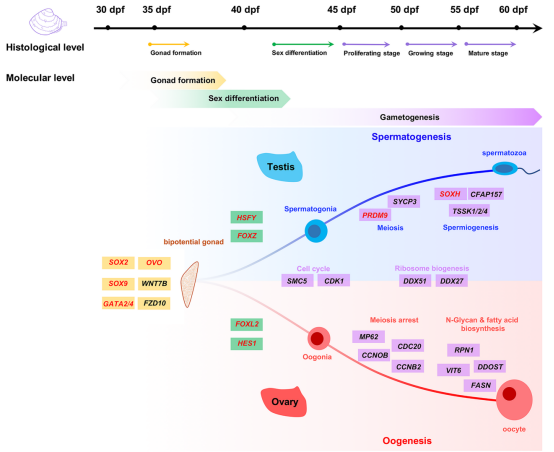
Our recent progress in deciphering the mechanisms underlying gonadal development in molluscs
On December 2nd, we published an article entitled “Dynamic transcriptome analysis reveals the gene network of gonadal development from the early history life stages in dwarf surfclam Mulinia lateralis” in the journal Biology of Sex Differences. This study provides a deep insight into the molecular basis of gonad formation, sex differentiation and gametogenesis in Mulinia lateralis.
Mollusca, including bivalves, gastropods, cephalopods, composes the second-largest phylum of animal kingdom after arthropods, with around 200,000 extant species widespread in marine, fresh water and on land. Many molluscs, particularly bivalves such as oysters, scallops, clams and mussels, are an important food source for humans. Research on the gonadal development of molluscs not only helps to understand the molecular mechanism of sex differentiation and gametogenesis, but also facilitates reproductive control in aquaculture. However, related information remains limited in molluscs owing to the long generation time and the difficulty in maintaining whole life cycle in the lab. The dwarf surfclam M. lateralis (Figure 1) is considered an ideal bivalve model due to the short generation time and ease to breed in the lab.

Figure 1 Photograph (left panel) and schematic diagram (right panel) of the anatomy of M. lateralis showing the internal structure (the left shell valve was removed)
To gain a comprehensive understanding of gonadal development in M. lateralis, the authors conducted a combined morphological and molecular analysis on the gonads of 30 to 60 dpf, revealing the timing of gonad formation, sex differentiation and gametogenesis (Figure 2). The gene coexpression network analysis on 40 transcriptomes identifies seven gonadal development-related modules, including gonad-forming modules, sex-specific modules, and sexually shared modules. The modules participate in different biological processes, such as cell communication, glycan biosynthesis, cell cycle, and ribosome biogenesis. Several hub transcription factors including SOX2, HSF and FOXL2 are identified. These findings will contribute to a comprehensive understanding of the reproductive regulation network in molluscs.
The corresponding author and first author of this work are Prof. Lingling Zhang and Dr. Yajuan Li, respectively. The work was supported by the National Natural Science Foundation of China and Key R&D Project of Shandong Province.

Figure 2 Schematic diagram of the gonadal development of M. lateralis based on the histological and molecular analyses
News: https://bsd.biomedcentral.com/articles/10.1186/s13293-022-00479-3

